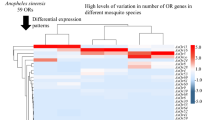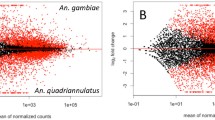Abstract
Olfaction plays a major role in host-seeking behaviour of mosquitoes. An informatics-based genome-wide analysis of odorant-binding protein (OBP) homologues is undertaken, and 32 putative OBP genes in total in the whole genome sequences of Anopheles gambiae are identified. Tissue-specific expression patterns of all A. gambiae OBP candidates are determined by semi-quantitative Reverse Transcription (RT)-PCR using mosquito actin gene as internal expression control standard. The results showed that 20 OBP candidates had strong expression in mosquito olfactory tissues (female antennae), which indicate that OBPs may play an important role in regulating mosquito olfactory behaviours. Species-specific expression patterns of all putative anopheline OBPs are also studied in two of the most important malaria vectors in A. gambiae complex, i.e. A. gambiae and A. arabiensis, which found 12 of the putative OBP genes examined displayed species-differential expression patterns. The cumulative relative expression intensity of the OBPs in A. arabiensis antennae was higher than that in A. gambiae (the ratio is 1441.45:1314.12), which might be due to their different host preference behaviour. While A. gambiae is a highly anthropophilic mosquito, A. arabiensis is more opportunistic (varying from anthropophilic to zoophilic). So the latter should need more OBPs to support its host selection preference. Identification of mosquito OBPs and verification of their tissue- and species-specific expression patterns represent the first step towards further molecular analysis of mosquito olfactory mechanism, such as recombinant expression and ligand identification.
Similar content being viewed by others
References
Curtis, C. F., Introduction I: An overview of mosquito biology, behaviour and importance, in Olfaction in Mosquito-Host Interactions (eds. Bock, G. R., Cardew, G.), New York: Wiley, 1996, 3–7.
Nighorn, A., Hildebrand, J. G., Dissecting the molecular mechanisms of olfaction in a malaria-vector mosquito, PNAS, 2002, 99(3): 1113–1114.[DOI]
Field, L. M., Pickett, J. A., Wadhams, L. J., Molecular studies in insect olfaction, Insect Mol. Biol., 2000, 9(6): 545–551. [DOI]
Krieger, J., Breer, H., Olfactory reception in invertebrates, Science, 1999, 286(5440): 720–723.[DOI]
Singh, R. N., Nayak, S. V., Fine structure and primary sensory projections of sensilla on the maxillary palp of Drosophila melanogaster Meigen (Diptera: Drosophilidae), Int. J. Insect Morphol. Embryol., 1985, 14: 291–306.
Pelosi, P., Maida, R., Odorant-binding proteins in insects, Comp. Biochem. Physiol., 1995, 111B: 503–514.
Vogt, R. G., Callahan, F. E., Rogers, M. E. et al., Odorant binding protein diversity and distribution among the insect orders, as indicated by LAP, an OBP-related protein of the true bug Lygus lineolaris (Hemiptera, Heteroptera), Chem. Senses, 1999, 24(5): 481–495.[DOI]
Vogt, R. G., Riddiford, L. M., Pheromone binding and inactivation by moth antennae, Nature, 1981, 293: 161–163.
Vogt, R. G., Köhne, A. C., Dubnau, J. T. et al., Expression of pheromone binding proteins during antennal development in the gypsy moth Lymantria dispar, J. Neurosci., 1989, 9: 3332–3346.
Breer, H., Boekhoff, I., Krieger, J. et al., Molecular mechanism of olfactory signal transduction, in Sensory Transduction (eds. Corey, D. P., Roper, S. D.), New York: The Rockefeller University Press, 1992, 94–108.
Vogt, R. G., Rybczynski, R., Cruz, M. et al., Ecdysteroid regulation of olfactory protein expression in the developing antenna of the tobacco hawk moth Manduca sexta, J. Neurobiol., 1993, 24: 581–597.
Pelosi, P., Odorant binding proteins, Crit. Rev. Biochem. Mol. Biol.T, T1994, 29: 199–228.
Steinbrecht, R. A., Laue, M., Ziegelberger, G., Immunolocalization of pheromone-binding protein and general odorant-binding protein in olfactory sensilla of the silk moths Antheraea and Bombyx, Cell Tissue Res., 1995, 282:203–217.[DOI]
Robertson, H. M., Martos, R., Sears, C. R. et al., Diversity of odourant binding proteins revealed by an expressed sequence tag project on male Manduca sexta moth antennae, Insect Mol. Biol., 1999, 8(4): 501–518.[DOI]
Holt, R. A., Subramanian, G. M., Halpern, A. et al., The genome sequence of the malaria mosquito Anopheles gambiae, Science, 2002, Oct 4, 298(5591): 129–149.[DOI]
Takken, W., The role of olfaction in host-seeking of mosquitoes: A review, Insect Sci. Applic., 1991, 12: 287–295.
Bowen, M. F., Sensory aspects of host location in mosquitoes, Ciba Foundation Symposia, 1996, 200: 197–211.
Takken, W., Synthesis and future challenges: The response of mosquitoes to host odours, Ciba Found Symp., 1996, 200: 302–312.
Hunt, R. H., Coetzee, M., Fettene, M., The Anopheles gambiae complex: A new species from Ethiopia, Tran. R. Soc. Trop. Med. Hyg., 1998, 92: 231–235.[DOI]
Coetzee, M., Craig, M., le Sueur, D., Distribution of African malaria mosquitoes belonging to the Anopheles gambiae complex, Parasitol Today, 2000, 16: 74–77.[DOI]
Onyabe, D. Y., Conn, J. E., Population genetic structure of the malaria mosquito Anopheles arabiensis across Nigeria suggests range expansion, Mol. Ecol., 2001, 10: 2577–2591.[DOI]
Ingrid, V. F. van den Broek, Cornelis, J. den Otter, Olfactory sensitivities of mosquitoes with different host preferences (Anopheles gambiae s.s., A. arabiensis, A. quadriannulatus, A. m. atroparvus) to synthetic host odours, J. Insect Physiol., 1999, 45: 1001–1010.[DOI]
Prior, A., Torr, S. J., Host selection by A. arabiensis and A. quadriannulatus feeding on cattle in Zimbabwe, Med. Vet. Entomol., 2002, 16: 207–213.[DOI]
Pates, H. V., Akken, W. T., Curtis, C. F. et al., Unexpected anthropophilic behaviour in Anopheles quadriannulatus, Med. Vet. Entomol., 2001, 15: 293–298.[DOI]
White, G. B., Anopheles gambiae complex and disease transmission in Africa, Transactions of the Royal Society for Tropical Medicine and Hygiene, 1974, 68:278–298.
Garrett-Jones, C., Boreham, P. F. L., Pant, C. P., Feeding habits of anophelines (Diptera: Culicidae) in 1971–78, with reference to the human blood index: A review, Bulletin of Entomological Research, 1980, 70:165–185.
Gillies, M. T., Coetzee, M., A supplement to the Anophelinae of Africa south of the Sahara (Afrotropical region), Publications of the South African Institute for Medical Research, 1987, 55: 1–143.
Macdonald, G., The Epidemiology and Control of Malaria, London: Oxford University Press, 1957.
Biessmann, H., Walter, M. F., Dimitratos, S. et al., Isolation of cDNA clones encoding putative odourant binding proteins from the antennae of the malaria-transmitting mosquito, Anopheles gambiae, Insect Mol. Biol., 2002, 11 (2): 123–132.[DOI]
James, A.A., Blackmer, K., Marinotti, O. et al., Isolation and characterization of the gene expressing the major salivary gland protein of the female mosquito, Aedes aegypti, Mol. Biochem. Parasitol., 1991, 44 (2): 245–253.[DOI]
Vogt, R. G., Odorant binding protein homologues of the malaria mosquito Anopheles gambiae; possible orthologues of the OS-E and OS-F OBPs of Drosophila melanogaster, J. Chem. Ecol., 2002, 28(11): 2371–2376.[DOI]
Fox, A. N., Pitts, R. J., Zwiebel, L. J., A cluster of candidate odorant receptors from the malaria vector mosquito, Anopheles gambiae, Chem. Senses, 2002, 27(5): 453–459.[DOI]
Xu, P. X., Zwiebel, L. J., Smith, D., Identification of a distinct family of genes encoding atypical odorant-binding proteins in the malaria vector mosquito, Anopheles gambiae, Insect Mol. Biol., 2003, 12(6): 549–560.[DOI]
Author information
Authors and Affiliations
Corresponding author
Rights and permissions
About this article
Cite this article
Li, Z., Zhou, JJ., Shen, Z. et al. Identification and expression profiling of putative odorant-binding proteins in the malaria mosquitoes, Anopheles gambiae and A. arabiensis . Sci. China Ser. C.-Life Sci. 47, 567–576 (2004). https://doi.org/10.1360/03yc0232
Received:
Revised:
Issue Date:
DOI: https://doi.org/10.1360/03yc0232




